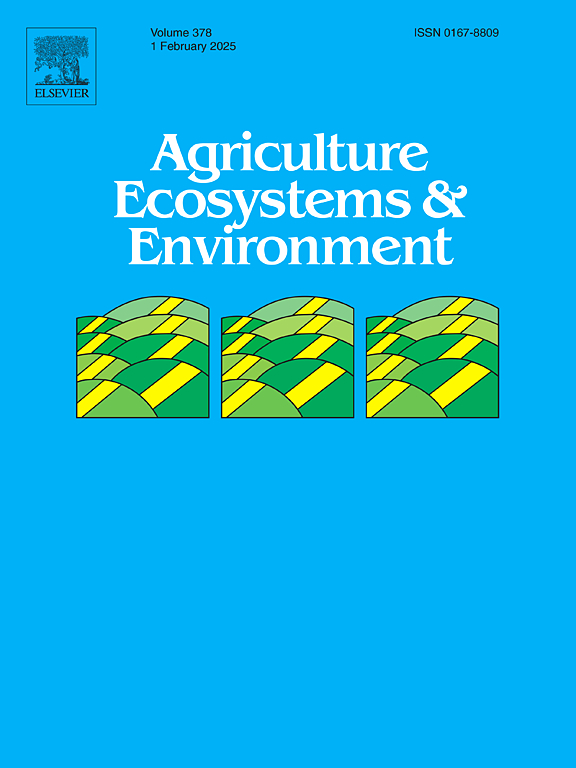土地利用转换削弱了植物多样性对草地高营养层时间稳定性的级联效应
IF 6
1区 农林科学
Q1 AGRICULTURE, MULTIDISCIPLINARY
引用次数: 0
摘要
土地利用集约化会危及生物多样性和生态系统的稳定性,而土地利用转换对多空间尺度上多营养水平稳定性的影响,特别是在高营养水平上植物多样性与生物量时间稳定性之间的联系仍有待阐明。通过4年的野外调查,定量分析了天然草原向管理草原转变过程中,植物、草食、掠食性和杂食性甲虫生物量在物种(种群稳定性)、群落(α稳定性)和群落间(γ稳定性)水平上的时间稳定性。研究发现,天然草地群落由于植物多样性较高,物种间的动态变化具有较大的非同步性,而管理草地群落的种群动态变化较为稳定,在土地利用集约化梯度上具有相似的α稳定性和γ稳定性。土地利用转换通过降低物种间和群落间的非同步动态来降低捕食者的α和γ稳定性,进而降低甲虫的α和γ稳定性。重要的是,我们的研究结果表明,植物多样性通过生物多样性在营养水平之间的级联效应增强了高营养水平生物量的时间稳定性,但随着自然草地向管理草地的转变,这种效应被削弱。研究结果表明,土地利用变化对时间稳定性的负面影响依赖于营养水平而非空间尺度,并强调了土地利用集约化在高营养水平上解耦了植物多样性与生物量稳定性之间的联系。本文章由计算机程序翻译,如有差异,请以英文原文为准。
Land use conversion weakens the cascading effects of plant diversity on temporal stability of high trophic levels at multiple spatial scales in grasslands
Land use intensification is known to imperil biodiversity and ecosystem stability, while the effects of land use conversion on the stability of multiple trophic levels at multiple spatial scales, particularly the linkages between plant diversity and the temporal stability of biomass at high trophic levels, remain to be elucidated. We conducted a 4![]() year field investigation to quantify the temporal stability of biomass for plants and herbivory, predatory, and omnivorous beetles at the species (population stability), community (alpha stability), and among communities (gamma stability) levels as natural grasslands convert to managed grasslands. We found local communities in natural grasslands exhibited greater asynchronous dynamics among species due to high plant diversity, but exhibited more stable population dynamics in managed grasslands, resulting in similar alpha stability and then gamma stability along the land use intensification gradients. Land use conversion decreased the alpha and gamma stability of predators by decreasing asynchronous dynamics among species and communities, respectively, and then decreased beetle alpha and gamma stability. Importantly, our results revealed that plant diversity enhanced the temporal stability of biomass at higher trophic level through the biodiversity cascading effects among trophic levels, but these effects were weakened as natural grasslands convert to managed grasslands. Our findings demonstrate that the negative effects of land use change on temporal stability relies on trophic levels but not spatial scales, and highlight that land use intensification decouples the links between plant diversity and the stability of biomass at higher trophic levels.
year field investigation to quantify the temporal stability of biomass for plants and herbivory, predatory, and omnivorous beetles at the species (population stability), community (alpha stability), and among communities (gamma stability) levels as natural grasslands convert to managed grasslands. We found local communities in natural grasslands exhibited greater asynchronous dynamics among species due to high plant diversity, but exhibited more stable population dynamics in managed grasslands, resulting in similar alpha stability and then gamma stability along the land use intensification gradients. Land use conversion decreased the alpha and gamma stability of predators by decreasing asynchronous dynamics among species and communities, respectively, and then decreased beetle alpha and gamma stability. Importantly, our results revealed that plant diversity enhanced the temporal stability of biomass at higher trophic level through the biodiversity cascading effects among trophic levels, but these effects were weakened as natural grasslands convert to managed grasslands. Our findings demonstrate that the negative effects of land use change on temporal stability relies on trophic levels but not spatial scales, and highlight that land use intensification decouples the links between plant diversity and the stability of biomass at higher trophic levels.
求助全文
通过发布文献求助,成功后即可免费获取论文全文。
去求助
来源期刊

Agriculture, Ecosystems & Environment
环境科学-环境科学
CiteScore
11.70
自引率
9.10%
发文量
392
审稿时长
26 days
期刊介绍:
Agriculture, Ecosystems and Environment publishes scientific articles dealing with the interface between agroecosystems and the natural environment, specifically how agriculture influences the environment and how changes in that environment impact agroecosystems. Preference is given to papers from experimental and observational research at the field, system or landscape level, from studies that enhance our understanding of processes using data-based biophysical modelling, and papers that bridge scientific disciplines and integrate knowledge. All papers should be placed in an international or wide comparative context.
 求助内容:
求助内容: 应助结果提醒方式:
应助结果提醒方式:


